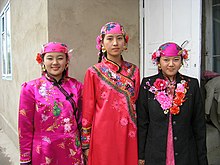Хуэйзў (回族) 東干族 | |
|---|---|
 Teenage Dungan girls posing for a photoshoot in traditional costume in Sortobe, Kazakhstan. | |
| Total population | |
| 175,782 | |
| Regions with significant populations | |
| 76,573[1] | |
| 74,409[2] | |
| 3,028[3] | |
| ∟ | 207 (2010)[4] |
| ∟ | 53 (2010)[4] |
| ∟ | 43 (2010)[4] |
| ∟ | 500 (2018)[4] |
| ∟ | 41 (2010)[4] |
| ∟ | 760 (2010)[4] |
| 6,000[citation needed] | |
| 5,300[citation needed] | |
| 1,900[citation needed] | |
| 133[5] | |
| Languages | |
| Dungan or Mandarin Chinese Secondary languages: | |
| Religion | |
| Sunni Islam | |
| Related ethnic groups | |
| Hui, Han | |
Dungan[a] is a term used in territories of the former Soviet Union to refer to a group of Muslim people of Hui origin.[6] Turkic-speaking peoples in Xinjiang also sometimes refer to Hui Muslims as Dungans.[7] In both China and the former Soviet republics where they reside, however, members of this ethnic group call themselves Hui because Dungans are descendants of historical Hui groups that migrated to Central Asia.
In the censuses of the countries of the former Soviet Union, the Dungans (enumerated separately from Chinese) are found in Kazakhstan (36,900 according to the 1999 census), Kyrgyzstan (58,409 according to the 2009 census) and Russia (801 according to the 2002 census).[8][9][3]
- ^ "Total population by nationality (assessment at the beginning of the year, people)". Bureau of Statistics of Kyrgyzstan. 2021.
- ^ "The population of the Republic of Kazakhstan by individual ethnic groups at the beginning of 2019". Statistics Committee of the Ministry of National Economy of the Republic of Kazakhstan. Archived from the original on 4 June 2020. Retrieved 8 January 2019.
- ^ a b "1. НАЦИОНАЛЬНЫЙ СОСТАВ НАСЕЛЕНИЯ" [1. NATIONAL COMPOSITION OF THE POPULATION] (in Russian). 6 October 2020.
- ^ a b c d e f Cite error: The named reference
ЭтноЯз.2010was invoked but never defined (see the help page). - ^ "About number and composition population of Ukraine by data All-Ukrainian census of the population 2001". Ukraine Census 2001. State Statistics Committee of Ukraine. Archived from the original on 17 December 2011. Retrieved 17 January 2012.
- ^ David Trilling (20 April 2010). "Kyrgyzstan Eats: A Dungan Feast in Naryn". EURASIANET.org.
- ^ "UNPO: East Turkestan: Strict Control of China's Uighur Muslims Continues". Unrepresented Nations & Peoples Organization. 16 August 2006. Retrieved 12 March 2020.
However, the authorities' control over Dungan mosques is less strict than over mosques used by Uighurs, a Turkic people mainly found in Xinjiang but also in Central Asian states. (The Dungans are a Chinese Muslim people also found in Central Asian states.)
- ^ "Демографический ежегодник Кыргызской Республики: 2009–2013.-Б: Нацстатком Кырг. Респ., 2014:-320с. ISBN 978-9967-26-837-1" (PDF). Bishkek: National Committee on Statistics. 2014. Archived from the original (PDF) on 6 October 2018. Retrieved 6 December 2014.
- ^ Aleksandr Nikolaevich Alekseenko (Александр Николаевич Алексеенко), "Republic in the Mirror of the Population Census" («Республика в зеркале переписей населения») Sotsiologicheskie Issledovaniia. 2001, No. 12. pp. 58–62.
Cite error: There are <ref group=lower-alpha> tags or {{efn}} templates on this page, but the references will not show without a {{reflist|group=lower-alpha}} template or {{notelist}} template (see the help page).